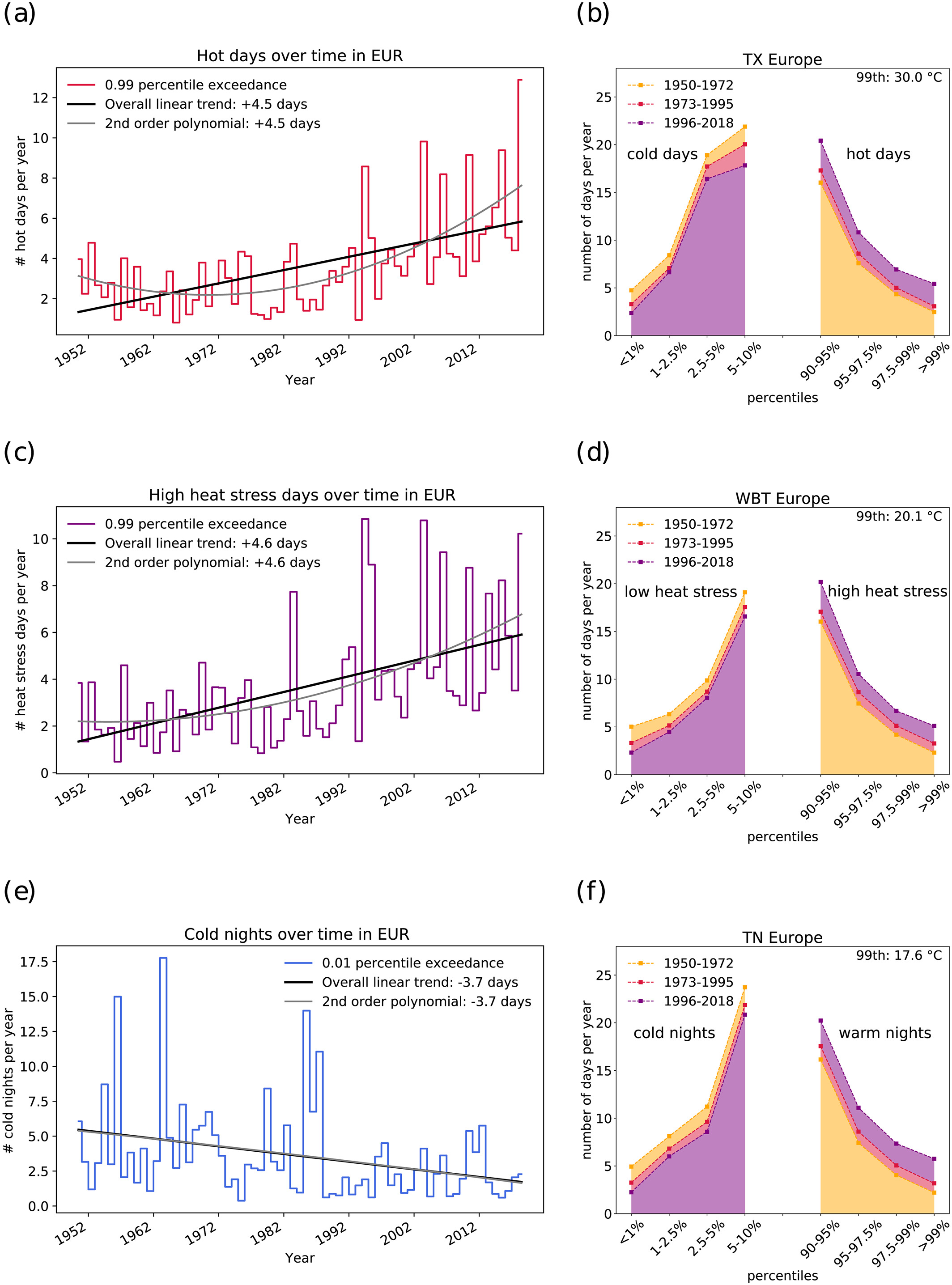博文
欧洲变暖速度超过预期
|||
欧洲变暖速度超过预期
诸平

Figure 1
Open in figure viewerPowerPoint
Frequency of hot (a, b), heat stress (c, d), and cold (e, f) extremes over time. The left column shows the number of days (a) TX > 99th percentile, (c) WBT > 99th percentile, and (e) TN < 1st percentile from 1950–2018 for region EUR. For illustration we added a linear trend and a second‐order polynomial. The right column shows the number of days which fall within certain percentile bins for three different time periods, 1950–1972 (orange), 1973–1995 (red), and 1996–2018 (purple). The percentiles were calculated using the whole time period 1950–2018. Be aware that the bins are unequally spaced and the middle of the distribution was excluded in the figure.
据瑞士苏黎世联邦理工学院大气与气候科学研究所(Institute for Atmospheric and Climate Science, ETH Zurich, Switzerland)的一项最新研究结果显示,气候变化正在导致欧洲极端高温天气的天数增加,同时也使极端寒冷天气的天数在逐渐减少,这将给欧洲居民在未来几十年带来风险。
2019年夏天,欧洲气温创历史新高,法国南部气温超过46.0 ℃。2019年7月17日发表在《地球物理研究快报》(Geophysical Research Letters)上的一项新研究发现——Ruth Lorenz, Zélie Stalhandske, Erich M. Fischer. Detection of a Climate Change Signal in Extreme Heat, Heat Stress, and Cold in Europe From Observations. Geophysical Research Letters, 2019, Volume 46, Issue 14. DOI: 10.1029/2019GL082062. First published: 17 July 2019. 自1950年以来,夏季极度炎热的天数增加了两倍,夏季总体变热,而冬季极度寒冷的天数则减少了至少一半,冬季总体变暖。
新的研究发现,欧洲部分地区的变暖速度比气候模型项目的预料要更快。瑞士苏黎世联邦理工学院(Swiss Federal Institute of Technology in Zurich, Switzerland)的气候科学家、也是上述研究的主导作者露丝·洛伦茨(Ruth Lorenz)说:“即使在整个欧洲的区域范围内,我们也可以看到,这些趋势比我们预期的自然变化要大得多。这确实是来自气候变化的一个信号。”
高温是危险的,因为它会对人体造成压力,可能导致中暑。科学家们知道气候变化正在使欧洲变暖,但他们主要研究的是极端温度下的长期变化。这项新研究观察了观测数据,以评估用于区域预测的气候模型是否能再现观测到的趋势。
在这项新研究中,露丝·洛伦茨和她的同事使用了欧洲气象站从1950年到2018年的观测数据,然后分析了这段时间最热的1%的极端天气和最高的湿度,以及最冷的1%的天气。
露丝·洛伦茨说:“我们进一步研究了每年最热的白天或最冷的夜晚,因此每年我们都在寻找最大值/最小值,以及随着时间的推移这些值是如何变化的。”
他们发现,自1950年以来,欧洲极端高温日的数量增加了两倍,而极端低温日的数量则根据地区的不同减少了两到三倍。极端炎热的日子平均变热了2.30℃,而极端寒冷的日子平均变暖了3.0℃。最热的白天和最冷的夜晚明显比相应的夏季和冬季平均气温要高。
作者说,整个欧洲的各个地区经历了截然不同的气温趋势,这使得很难将欧洲的平均气温与特定气象站的极端气温进行比较。洛伦茨说,在中欧,极端气温每十年比夏季平均气温高出0.14℃,相当于整个研究期间的平均气温高出近1.0℃。
据研究人员说,超过90%的气象站显示气候正在变暖,这一比例太高,不可能完全是自然气候变化造成的。
结果还表明,该地区变暖的速度比气候模型预测的要快。一些地区经历了比预期更高的极端情况,一些地区经历了比预期更低的极端情况。“在荷兰、比利时和法国,模型趋势比观察到的趋势低两倍左右,”荷兰皇家气象研究所(Royal Netherlands Meteorological Institute)的气候分析学家盖尔特·扬·范·奥尔登堡(Geert Jan van Oldenborgh)说,“我们创造新纪录的速度比想象的要快。”
研究报告的作者说,随着气候变化的加速,欧洲的夏季和冬季只会在未来几年变得更热,影响城市和对气温上升毫无准备的人们。洛伦茨说:“举例来说,很多人没有空调,这使得这一点非常重要。“我们期待基于模型研究的结果,但这是我们迄今为止观察到的第一次发现。”更多信息请注意浏览原文或者相关报道。
Abstract
In the last two decades Europe experienced a series of high‐impact heat extremes. We here assess observed trends in temperature extremes at ECA&D stations in Europe. We demonstrate that on average across Europe the number of days with extreme heat and heat stress has more than tripled and hot extremes have warmed by 2.3 °C from 1950–2018. Over Central Europe, the warming exceeds the corresponding summer mean warming by 50%. Days with extreme cold temperatures have decreased by a factor of 2–3 and warmed by more than 3 °C, regionally substantially more than winter mean temperatures. Cold and hot extremes have warmed at about 94% of stations, a climate change signal that cannot be explained by internal variability. The clearest climate change signal can be detected in maximum heat stress. EURO‐CORDEX RCMs broadly capture observed trends but the majority underestimates the warming of hot extremes and overestimates the warming of cold extremes.
https://blog.sciencenet.cn/blog-212210-1195888.html
上一篇:青海之旅照片
下一篇:微型温度计测热寻靶标(附原文)